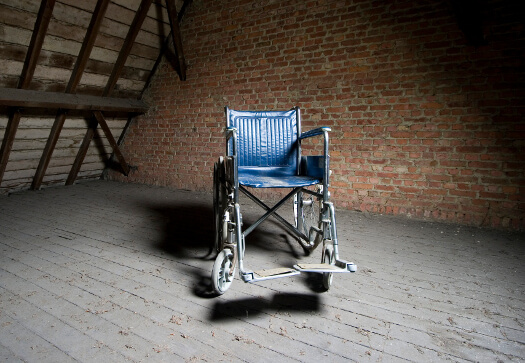In order to understand the process by which meditation works to improve our experiences with chronic pain, we should examine the evidence supporting the premise itself. In short: how do we know that meditation works at all?
 Studies Establish Meditation’s Effectiveness in Chronic Pain Management
Studies Establish Meditation’s Effectiveness in Chronic Pain Management
Numerous studies have consistently found the same thing: meditation works on chronic pain — not just in our emotional reaction to it, but also the pain itself.
One study, published in the Journal of Neuroscience (Feb. 2008), found that chronic back pain patients demonstrated an always-active area in the frontal cortex associated with emotion, whereas healthy brains (in healthy non-pained patients) show those areas “go dark” from time to time. As columnist Jackie Gingrich Cushman notes in this article, meditation can help train the brain over time to “take a break,” as it were.
A Canadian physician found in one study that meditation of 10 to 20 minutes a day, over a period of ten weeks, significantly helped many patients to manage their pain. One participant, whose pain was so intense that she’d even considered suicide, noted she was “shocked” at how significant the impact on her pain was. (You can read more about the mindfulness method developed by Jon Kabat-Zinn which was used in the Canadian study here at NPR.)
In fact, Kabat-Zinn is somewhat of a pioneer in this area of study. His own studies served as the catalyst for many subsequent researchers. The abstract from one of those studies is here at his site, Wild Mind.
Another fibromyalgia study, this one conducted in Switzerland at the University of Basel Hospital, showed that a mindfulness meditation program yielded several key benefits in patients, including pain-induced suffering, anxiety, and depression. A follow-up three years showed continued benefits for those who stayed with the process.
Studies have also shown that a relaxed mind, one of the major benefits of meditation, is more capable of remembering and processing information, which might help alleviate that fibro fog and similar fuzzy states of mind we all hate so much.
The Mechanism Behind Mindfulness Meditation’s Impact on Chronic Pain
To get to the “whys” and “wherefores” we should review what happens in a normal pain response in a healthy individual:
- A painful stimulus is applied — be it a hand on a hot stove or an injury in a car wreck;
- The nervous system sends the “IM” as it were to command central: “Injury: Possible Pain Ahead”
- The brain then acts like a relay station of sorts. It sends out the message, much like a PA system, to what’s been called “the pain matrix” — an association of brain areas responsible for different functions that, collectively, help us process and learn from the experience (more on this below)
- Those areas jump into action, sending the signal to the rest of the body to either stop interacting with the painful stimulus (“take your hand off the stove, idiot!”) or prepare for biophysical stress (“this is gonna hurt”)
- The brain’s various structures then learn from the experience thanks to a characteristic known as neuroplasticity.
To get to the heart of how meditation works, we need to focus on steps 3 and 4 — the sending of the signal to the pain matrix, and the various commands that then issue from the brain to the rest of the body in response.
The Functions of the Pain Matrix
In step 3, the PA message goes out to the pain matrix, which consists of those areas of the brain with the following functions:
- Turning the signal into a physical pain sensation — so you become aware of all this stuff (that’s happening at lightning speeds, of course — much too fast to discern separately)
- Keeping track of goals and conflict — so you can start to solve the problem of how to make this unpleasant experience better
- Processing emotions, thereby triggering fear and anger — so you become motivated to protect yourself
That last one, in particular, is important. It’s easy to look at this process and say “well, the emotional stuff, it should just go away. Who needs to feel such negative emotions all the time?” But in fact that’s a crucial part of the healthy pain response! Without it, you’d likely just keep doing the same thing over and over, because it wouldn’t have become something you desire to avoid .
Now, that’s a healthy response. But in chronic pain, the response gets all screwed up. Those hormones that flood our body in step 4, preparing us to “fight or flee”, don’t dissipate like they should. The emotional response continues longer than it would otherwise. In short, we get stuck in this cycle. Like the Energizer bunny — it all just keeps going and going and going …
What meditation does is akin to short-circuiting that cycle. It breaks the emotional response (which only serves to amp up our suffering). It calms the biochemical stress response. It allows us to experience the pain without suffering through it.
My personal experience with this phenomenon tells me that the benefits are not only immediate but also cumulative. That is, you get an initial improvement in your well-being, sure — but over time, those benefits add up.
Now, when I go into a flare now (and of course, it still happens) my meditation practice has now retrained my brain to approach the experience with equanimity:
- I don’t get upset.
- I don’t feel nauseated afterwards (which is due to the overflow of adrenaline that’s produced in the pain response).
- I don’t feel that rage and debilitating fear that grips so many of us — and used to grip me tight, to be sure.
Want to Know More?
In a few days, I’ll share some solid tips and tools on how to implement a meditation practice, even if you’ve never meditated before.
If you want the full New Agey “whoo-whoo” experience, I’ll give you some suggestions to bliss out with the incense for the whole experience. If you’d rather keep it simple, I can help you there, too. No matter what your preferences, there is a meditation practice that’s right for you, and it will help you feel better. I promise.
Do you meditate? How has your experience with your chronic pain changed as a result of the meditation practice? Share your stories with us in the comments!
Photo Credit: kattebelletje via photopin cc
